In a spontaneous round of word association, it’s a fair bet your response to ‘Suzuki’ will be motorcycles. A massive force on two wheels, the brand is in fact a manufacturing all-rounder, producing bikes, ATVs, marine engines and, of course cars, in plants (often through joint-venture) around the world.
Suzukis of the four-wheeled variety have had their moments in the sun; the diminutive Swift has built a loyal following over successive generations, the Sierra (now oddly named Jimny Sierra) is a long-term campaigner at the budget end of the 4WD spectrum, and the Vitara consistently nips off a decent slice of the small SUV market.
But so far, the impact of light hatch stones slung by this automotive David have been unable to make relative Goliaths like Hyundai, Mazda and Toyota even flinch.
Enter the fourth-generation Baleno, Suzuki’s fresh compact hatch challenger. Launched locally in mid-2016, it offers a value-focused alternative to the big three, and we’ve driven the top-spec GLX Turbo to determine if they have anything to worry about.
Is there anything interesting about its design?
According to Suzuki’s chief engineer for the Baleno program, Kunihiko Ito, the aim in creating the car was to, “develop the ideal hatchback, one that makes no compromises, giving it an elegant, sophisticated and grown-up character.”
Translation issues notwithstanding, Ito-san is obviously a special in the lofty goals department, and the design team dutifully sank its teeth into that Everest-scale challenge.
The group’s theme may have been ‘Liquid Flow’, but surely a tree fell in the stream because there are swirls and eddies in the Baleno’s exterior we’re not exactly thrilled by.
Always a subjective call, but to our eyes the car’s proportions, particularly around the rear three quarters, are out of kilter. The 16-inch alloy rims look tiny thanks largely to a broad expanse of sheetmetal above them, pushing up to an elevated waistline and giving the Baleno a distinctly Harry High Pants stance.
The Baleno punches well above its weight when it comes to interior space.
And while undoubtedly distinctive, extended headlight graphics make the car’s face look like that of a midnight oil burning uni student keeping their eyelids open with matchsticks.
Aside from these contentious elements, the rest of the Baleno is unexceptional, with tail-lights vaguely reminiscent of the Merc A-Class’s (or any number of other hatches), and touches of chrome on the door handles (plus a random strip across the base of the rear window) not doing enough to stand the car apart.
The interior is inoffensive but uninspiring, with a conservative colour palette moving through light grey to charcoal, offset by metal-effect inserts on the dash, doors and console.
The centre dash is dominated by a Transformers chest plate-style treatment long favoured by a number of other brands, including Ford, Hyundai and Kia.
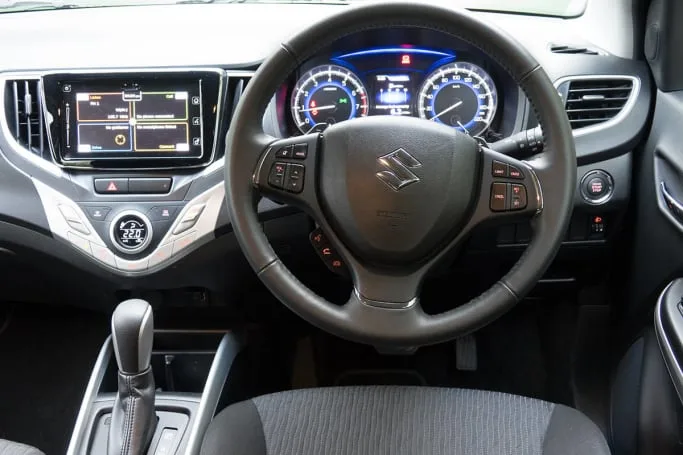
Although dashtop and door profiles roll gently in accordance with the Baleno’s aquatic design theme, the rock hard plastic they’re made from definitely breaks the spell. And the cloth trim leans more towards practical and hard wearing than ‘elegant and sophisticated.’
How practical is the space inside?
I’m 183cm tall, and sitting behind my own driving position there’s a handy gap in front of my knees and above my noggin.
Although it competes in the hatchback little league the Baleno punches well above its weight when it comes to interior space.
At just under 4.0m long, 1.75m wide, and 1.5m high, the little Suzuki aligns directly with its main Hyundai Accent, Mazda2, Toyota Yaris competition in terms of external dimensions, and its 2520mm wheelbase is marginally shorter than all but the diminutive Yaris. Yet, somehow, the Baleno manages to go full Tardis inside.
Suzuki says the car’s compact engine and the specific angle it sits at has liberated extra space, but the result feels more like packaging voodoo.
There’s plenty of head and shoulder room in the front with a pair of cupholders, reasonable oddments space (including a lidded bin between the seats), a decent glove box and deep door pockets (including space for bottles) on offer. A 12 volt outlet, line-in socket, and single USB port are also installed.
Rear head and legroom are also excellent. I’m 183cm tall, and sitting behind my own driving position there’s a handy gap in front of my knees and above my noggin. That said, three full-size grown-ups across the back would be a squeeze for all but short-range journeys.
While there’s lots of space on offer things are otherwise spartan for back-seaters. No centre armrest, cupholders, or adjustable air vents, just a lonely 12 volt outlet above a cubby hole in the back of the front centre console, one seatback map pocket (on the passenger side) and door bins (again, providing room for bottles).
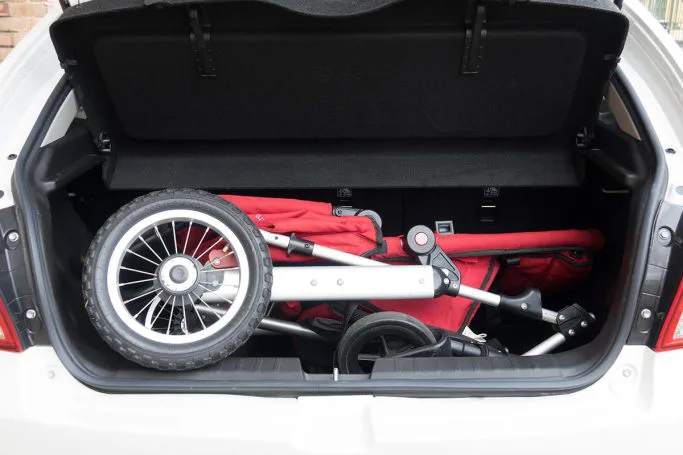
Fold the rear seat down and 756 litres of space opens up, which is a handy step above the class norm, but you won’t find a 12 volt outlet or tie-down hooks back there.
An 80km/h-limited space saver spare tyre is hidden under the cargo floor.
Does it represent good value for the price? What features does it come with?
At $21,990, before on-road costs, the Baleno GLX Turbo doesn’t exactly undercut the market. While that price tag isn’t outrageous, it’s certainly all the money for a light hatch.
The good news is the required dollars secure a respectable standard equipment list including, keyless entry and start, climate control air conditioning, cruise control (with speed limiter), HID headlights, front fog lights, rear camera, and 16-inch alloy wheels.
A 7.0-inch colour touchscreen connects with smartphone apps including Apple CarPlayand MirrorLink, while also managing the excellent 3D ‘Art Map’ sat nav and a six-speaker audio system incorporating radio (AM/FM/DAB), voice recognition, and Bluetooth connectivity.
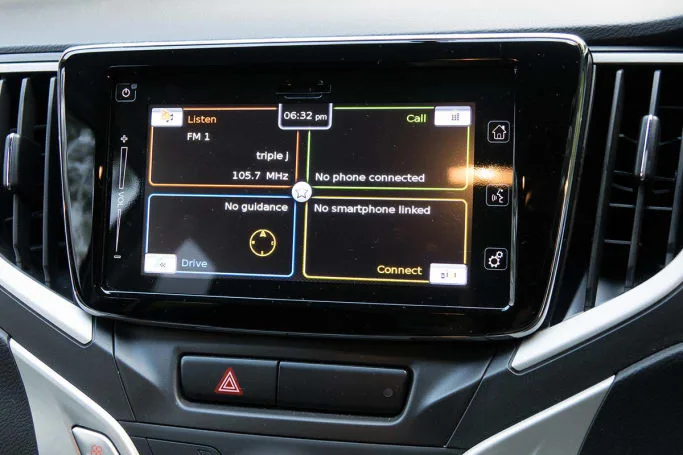
An ‘Advanced Multi-Information Display’ in the centre of the main instrument binnacle is built around a 4.2-inch colour LCD display covering a vast array of information, from the usual clock, outside temp, and fuel consumption read-outs, to more exotic data including, ‘Driving G-force’, engine output and torque, as well as accelerator and brake operation. Not bad.
What are the key stats for the engine and transmission?
Arguably, the biggest differentiator between the Suzuki Baleno and its key competitors sits snugly under the bonnet, because at the first turn of the key the distinctively gruff but agreeable growl of a three cylinder petrol engine echoes through the cabin.
The 998cc (K10C) ‘Boosterjet’ turbo triple produces 82kW at 5500rpm, and 160Nm across an impressively flat band from 1500-4000rpm.
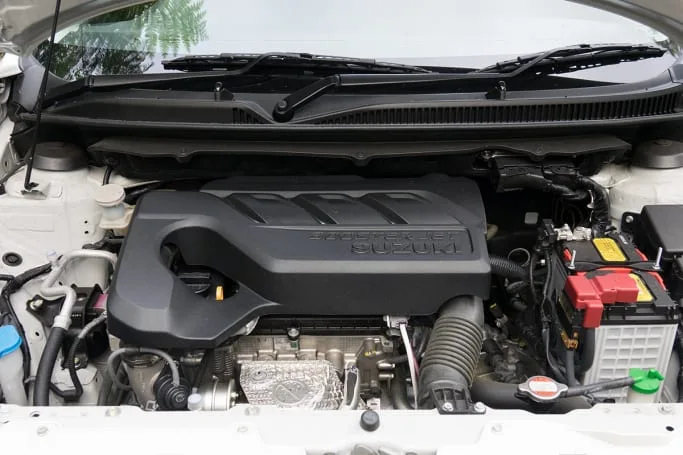
In an attempt to walk the eternally vexing line between performance and economy Suzuki’s white coats have thrown everything, including the kitchen sink (with gold-plated tapware), at this compact, direct-injection, 12-valve engine.
The rorty exhaust note is typical of a three cylinder, making the pint-size Baleno the automotive equivalent of a toddler babbling in baritone.
How about injectors with six-hole nozzles, high-tumble ports, a variable fuel pressure control system, specific turbo wastegate opening control, variable (intake side) valve timing, and high-rigidity, high-tensile parts? You get the idea…
The standard six-speed automatic transmission transfers drive to the front wheels only, and features wheel-mounted paddles for manual changes.
Suzuki quotes 5.2L/100km for the Baleno GLX Turbo over the combined (urban/extra urban) fuel cycle, emitting 121g/km of CO2 in the process. The on-board computer on our test example read 6.2 L/100km after close to 300km of city, suburban and freeway running.
Fuel requirement is 95RON premium unleaded, and the tank holds a mighty 37 litres, providing a theoretical range of more than 700km.
What’s it like to drive?
The Baleno GLX Turbo might be one cylinder down on the rest of the light car mob, but it gives little away in terms of comfort, speed and dynamics.
The rorty exhaust note is typical of a three cylinder, making the pint-size Baleno the automotive equivalent of a toddler babbling in baritone.
Acceleration, while far from earth-shattering, is frisky enough to keep the car’s head above water in the city and suburbs. Suzuki doesn’t quote a 0-100km/h time, but the stopwatch will tick well into double figures before you reach the ton. Bank on around 11.5 seconds.
With a clear focus on fuel economy and low exhaust emissions the transmission is keen to change up at every opportunity. But that’s not as much of a problem as it might otherwise be because the turbo’s torque peaks from just 1500rpm.
The front seats may look practical and plain but proved supportive enough over a couple of lengthy runs.
Fifth and sixth gears are overdriven, which means at 100km/h the engine’s ticking over at around 2000rpm in top, which gives the Baleno decent legs on the highway.
Flipping over to manual wrests back control if you’re determined to press on, although the shifts themselves aren’t exactly snappy. There’s a trace of lag as the turbo spools up from low revs, but it’s not a major issue.
Despite weighing in as a 975kg featherweight, the Baleno’s strut front, torsion beam rear suspension, with comfy (185/55) Bridgestone Ecopia rubber in support, delivers more than acceptable ride comfort, while steering response and feel are surprisingly good.
The front seats may look practical and plain but proved supportive enough over a couple of lengthy runs. Note of caution if you’re planning the occasional fang though, lateral location is modest.
Brakes are discs all around (ventilated front) and proved more than capable of retarding the Baleno’s modest mass, even on an enthusiastic backroad run.
If you’re game, the Baleno GLX Turbo is certified to tow 400kg (unbraked) and 1000kg (braked).
What safety equipment is fitted? What safety rating?
In terms of active safety, the Baleno is equipped with ABS (including EBD), ESP (stability control), hill hold control, brake assist and a reversing camera.
And if metal ultimately meets metal there are six airbags (dual front, dual front side, and curtain), as well ISOFIX child seat anchorages on the outside rear seating positions (plus seat tether anchorages for all three rear positions).
The Baleno’s key class competitors – Hyundai Accent, Mazda2, Toyota Yaris – all rate a maximum five ANCAP stars for occupant and pedestrian protection, while the Suzuki is yet to be tested locally.
At the car’s mid-2016 launch, Suzuki Australia said it anticipated the Baleno would also score five ANCAP stars, but that hasn’t happened yet.
Worth noting Euro NCAP ranks the current Baleno at three stars, mainly due to the absence of assist features like AEB, pre-collision and lane assist, but it’s important to remember the specification of the model tested may vary from Australian examples.
What does it cost to own? What warranty is offered?
Suzuki offers a three year/100,000km warranty, and recommends servicing every six months/10,000km (whichever comes first).
Over the first 10 services the capped price figure for each workshop visit the Baleno GLX Turbo makes is $175… except for the fourth ($429), the sixth ($329), and the eighth ($469).
Verdict
The Suzuki Baleno GLX Turbo manages to pull several rabbits out of the hat. It’s roomier than it should be, delivers excellent economy with more than acceptable performance, and it’s comfortable. Ultimately, though, it doesn’t conjure up the design sophistication, safety spec, or value equation to seriously challenge equivalent models from the dominant players in the light car segment.
EXPERT RATING: 6.9/10
Reviewed & Driven by James Cleary, CarsGuide
Read the full review of Suzuki Baleno GLX Turbo on CarsGuide.
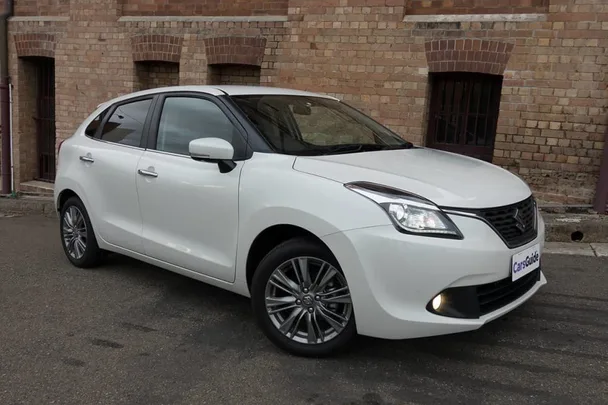 James Cleary
James Cleary









